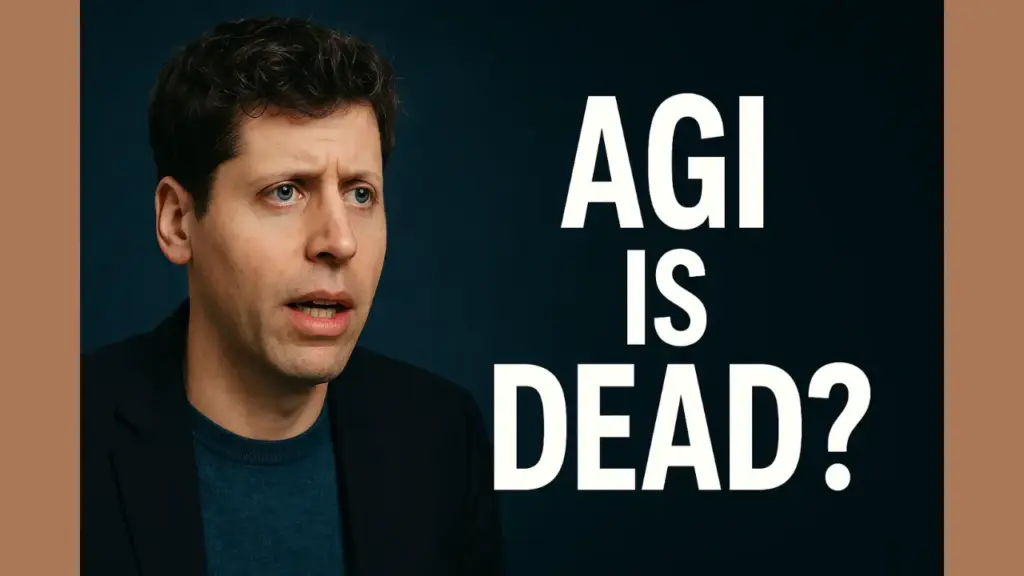Introduction
Is the dream of Artificial General Intelligence (AGI) over? Sam Altman, CEO of OpenAI, seems to suggest it might be. That claim stunned many in the tech world. After years of chasing AGI, Altman appears to be recalibrating the conversation. This shift has major implications. In this post, we’ll break it all down.
1. OpenAI’s AGI Ambitions: A Bold Beginning
OpenAI entered the scene with a bold goal: build AGI. Back then, the idea of a machine matching or surpassing human-level intelligence was thrilling. OpenAI aimed to develop a single system with broad capabilities across every domain. That vision drew massive investment. It also raised big expectations.
In speeches and blog posts, Altman pushed that vision. He painted a future where AGI could solve major global challenges. And many believed the hype. Yet, progress toward AGI remains elusive. The breakthroughs have come in narrow AI—impressive, but specialized.
2. Sam Altman’s Backtrack: What Changed?
Recently, Altman seemed to pivot. He signaled that AGI might no longer be the immediate focus. Instead, OpenAI seems to favor robust, narrow AI systems. These are powerful yet domain-specific. This shift surprised many observers.
The tone of public statements changed. Where once he framed AGI as inevitable, he now emphasizes caution. He highlights the complexities of scaling general-purpose systems. He also underscores safety, ethics, and regulation.
3. Why the Shift? Four Key Reasons
Technical Hurdles
AGI means more than better GPT models. It implies general reasoning, planning, and awareness. That remains unknown territory. Narrow AI continues to deliver gains. General AI, however, still lacks.
Ethical and Safety Concerns
A system with AGI power raises red flags. Without robust safeguards, it could act unpredictably. Altman now stresses safety. He underlines that rushing AGI could harm society.
Business and Funding Pressures
Investors seek returns. Narrow AI offers tangible products now. Tools like GPT for business get traction fast. AGI still feels speculative. From a business lens, it’s smarter to build tools that drive immediate value.
Here’s where the fractional cto concept becomes relevant. Many startups leverage fractional CTOs to steer AI product development wisely. They balance innovation with cost-efficiency. This approach mirrors OpenAI’s current direction: focus, execution, and measurable returns.
Regulatory Landscape
Policymakers watch AI closely. Broad, powerful systems trigger alarms. Altman’s refined stance may aim to ease regulatory scrutiny. By focusing on safer, narrower models, OpenAI can operate more smoothly.
4. Industry Reactions: Shock, Debate and Strategy
Altman’s shift triggered a wave of commentary.
AI researchers debated whether this is a true retreat or simply a pause.
Some view it as healthy realism.
Others worry it signals a slowdown in fundamental research.
Big tech rivals also reacted.
Companies like Google DeepMind still speak about AGI but quietly focus on narrower breakthroughs.
Startups are watching too.
Many young founders see an opening to build specialized AI products.
Here again the fractional CTO model becomes a talking point.
Founders hire fractional CTOs to gain high-level technical vision without full-time cost.
These leaders help startups pivot fast when industry winds change.
5. The Rise of Specialized AI Tools
The shift does not mean the end of innovation.
It means a pivot to specialization.
Instead of one model to rule them all, we see finely tuned systems for law, medicine, finance, and customer service.
Specialized tools offer clear benefits.
They solve defined problems.
They deliver measurable ROI.
They are easier to regulate and explain to users.
For businesses, this trend creates opportunity.
A fractional CTO can guide the integration of multiple specialized models into a single workflow.
This approach reduces risk and increases agility.
It also positions companies to adopt new models as they appear.
6. What This Means for Startups and Enterprises
For startups, the message is clear: build practical AI.
Avoid burning money on abstract AGI dreams.
Focus on products that solve pain points now.
For enterprises, the lesson is different but related.
They must rethink how to staff and manage AI initiatives.
Hiring a fractional CTO with experience in machine learning can be more cost-effective than building an in-house team from scratch.
Such leaders provide strategic oversight, vendor selection, and risk management.
This mirrors how OpenAI itself is behaving.
It is tightening its focus, choosing sustainable steps, and balancing innovation with responsibility.
7. The Future of AI Without AGI
The future without AGI is not bleak.
It is simply different.
We may not get a single omniscient machine soon, but we will see a proliferation of domain-specific AIs.
These systems will be faster, cheaper, and safer.
They will embed in everyday workflows.
They will boost productivity across industries.
Think of it as a network of expert agents rather than one general brain.
Each agent excels at a task.
Together they form a powerful ecosystem.
Again, a fractional CTO can orchestrate this ecosystem for a company.
They can choose the right tools, ensure compliance, and align AI strategy with business goals.
8. Building Trust and Authority in the AI Era
Under the EEAT framework — Expertise, Experience, Authoritativeness, and Trustworthiness — organizations must show they know what they’re doing.
That applies to OpenAI, startups, and even content creators.
Publishing transparent roadmaps, disclosing model limits, and highlighting human oversight all build trust.
Companies that do this will earn user confidence.
Those that overpromise risk reputational damage.
A clear, honest message like Altman’s recent statements may help rebuild credibility.
It signals that OpenAI recognizes the gap between hype and reality and is adjusting accordingly.

9. Conclusion: A New Era, Not the End
Sam Altman’s apparent backtrack does not kill the dream of AGI.
It reframes it.
The new focus on safety, specialization, and measurable impact could make AI more useful and less risky.
For startups, the lesson is to adopt a practical strategy.
Leverage specialized models.
Bring in experienced guidance — even if only through a fractional CTO — to steer technical decisions.
For observers and innovators, this is a moment to rethink expectations.
AGI may still arrive one day, but today’s opportunities lie in targeted solutions.
At startuphakk, we’ve been tracking these shifts closely.
This pivot shows why founders and tech leaders must stay informed, flexible, and evidence-driven.
The “death” of AGI is really the birth of a more grounded, more actionable AI era.




